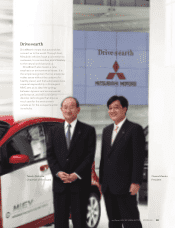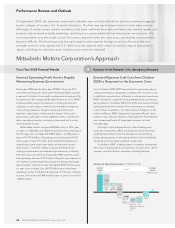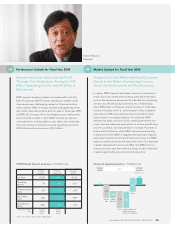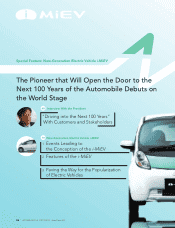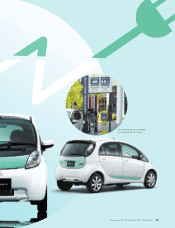Mitsubishi 2009 Annual Report Download - page 15
Download and view the complete annual report
Please find page 15 of the 2009 Mitsubishi annual report below. You can navigate through the pages in the report by either clicking on the pages listed below, or by using the keyword search tool below to find specific information within the annual report.
(2WD i-Turbo)
Quiet, agile, comfortable performance
EVs are intrinsically quiet because they do not run on internal combustion engines. The i-MiEV delivers even
greater quietness through focused improvements in motor noise, drive train noise, and road noise. Also, lever-
aging its superior response and high low-end torque inherent to its electric motor, the i-MiEV achieves a level of
responsive and powerful performance that surpasses that of the gasoline-powered turbo engine “i” minicar.
Ample range for everyday use
The i-MiEV has a single-charge cruising range of 160 km in the Japanese 10-15 mode urban driving pattern*1.
While the actual range is affected by such factors as the use of climate control and driving patterns, taking into
account the average Japanese daily driving distance*2, the i-MiEV achieves a range that is ample for everyday use.
Normal charge and quick charge
The i-MiEV’s drive battery can be charged at various locations, whether at home or when out and about. For
normal charging, the drive battery is connected to either a standard 100-volt or 200-volt household outlet.
The i-MiEV’s battery can also be charged at quick-charge stations, which are currently being established
throughout Japan.
2dB(A)
0-80km/h
0 5 10 15 20 25
0-80km/h
0-400m
0-400m
Noise level dB (A)
Time (second)
(2WD i-Turbo)
External noise comparison Acceleration from rest comparison
Full acceleration from 50km/hr (In-house measurements) (In-house measurements)
Normal
charging:
100 volts AC
Normal
charging:
200 volts AC
Ordinary households, etc. Quick charge stations
Quick
charging
*1: 10-15 mode is a specified test standard set by the Japanese Ministry of Land, Transport, and Infrastructure used to calculate cruising range. The actual range differs
according to a driver’s usage environment (weather, traffic conditions, etc.) and driving habits (e.g., sudden takeoffs, climate control system usage).
*2: A nationwide survey in Japan indicates that on average 90% of car drivers cover less than 40 km/day on weekdays and that 80% cover less than 60 km/day at
weekends and holidays (in-house research).
Method Power source Charge Time* (amount)
Normal
Charging
200V AC (15Amp) Approx. 7 hours (full charge)
100V AC (15Amp) Approx. 14 hours (full charge)
Quick
Charging
200V 3-phase 50 kW
(Using a quick-charging station)
Approx. 30 mins. (80% charge)
* Charging time calculated from power-down warning light indication.
These times are to be used as a guide. Actual charging times may vary depending on such
factors as air temperature and power source status.
13
Annual Report 2009 MITSUBISHI MOTORS CORPORATION


